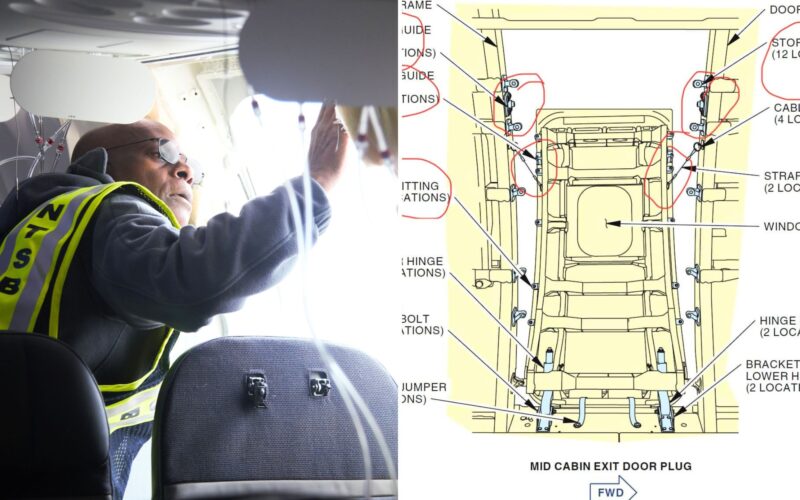The National Transport Safety Board (NTSB) has shared its initial findings following an investigation into flight 1282, disclosing what caused the door plug to separate from the aircraft’s fuselage, and noting what information Boeing needs to include in an updated manual.
What caused the door plug to blow out of the fuselage
Clint Crookshanks, Aerospace engineer at NTSB, explained what caused the door plug of the B737-9 MAX to expel from the fuselage.
“The exam to date has shown that the door in fact did translate upward. All 12 stops became disengaged, allowing [the door plug] to blow out of the fuselage. We found that both guide tracks on the plug were fractured,” Crookshanks said.
Crookshanks added: “We have not yet recovered the four bolts that restrain it from its vertical movement and we have not yet determined if they existed there. That will be determined when we take the door plug to our lab in Washington DC.”
The NTSB also said that although it is not key to the investigation, the board is still looking for the door plug’s bottom hinge fitting and a spring, issuing a call to the public to notify the NTSB if the items have been seen.
“No discrepancies” on the right door plug
Speaking at a media briefing on January 8, 2023, in Portland, Oregon, NTSB Chair Jennifer Homendy said that at this point the board could not explain why the door plug stops were disengaged.
The NTSB structures team examined the right door plug in its installed position, and found “no discrepancies.” However, Homendy said that the board will conduct another inspection of the right door plug at the maintenance position when it is open at 15 degrees.
No correlation between decompression and previous alarms
Homendy said that the expelled door plug is now in NTSB’s possession and will be sent to the board’s lab in Washington DC where it will undergo a more detailed examination. The cabin pressure controller’s memory will need to be downloaded and a 3D scan of the left frame where the door plug was expelled will be conducted, among other investigative tests.
According to Homendy, the NTSB had requested a specialist from Boeing to assist the board in these tests.
She also said “at this time” the NTSB had found no indication of a correlation between the aircraft’s rapid decompression and three instances of the “auto pressurization fail light” triggering reported in the month before the incident.
Boeing to make changes in manual
Homendy said the board found that the cockpit door of the B737-9 MAX was designed to open during rapid decompression and that the flight crew was not made aware of this feature. She added that Boeing will need to update its B737-9 MAX manual.
During the January 5, 2024 incident, the aircraft’s cockpit door opened violently mid-flight due to the decompression, and a flight attendant made three attempts to close the door. A laminated quick reference checklist used in emergencies flew out while the door was open.
“We found today that the cockpit door is designed to open during rapid decompression. However, no one among the flight crew knew that. They were not informed. So Boeing is going to make some changes to the manual which then hopefully will translate to procedures and information for the flight attendants and crew in the cockpit,” Homendy said.

